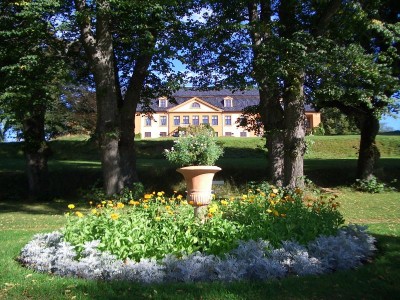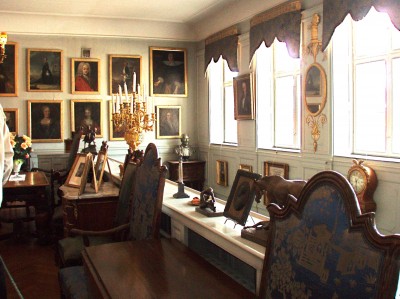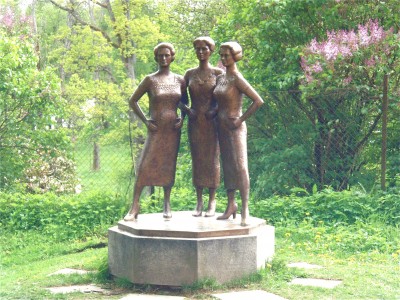MUSEUM GUIDE: Norway’s capital is full of museums, and they’re often in the news. We’re following that news, and aim to focus regularly on a specific museum or attraction worthy of a visit.
THIS WEEK: Bogstad Gård, a peaceful place to spend a sunny afternoon touring an 18th century manor, strolling the property, and relaxing in the café.

“Gård” in Norwegian means “farm.” Bogstad Gård, the name of the historic property on the outskirts of Oslo, should therefore be translated to “Bogstad Farm.” Few farmhouses are quite as splendid and lavish as this one.
Bogstad Gård was a private country retreat during the 1600s, and in 1773 became the permanent residence of Peder Anker – the man who in 1814 would become Norway’s first Prime Minister. Today, with its beautiful grounds along the lake also known as Bogstad, its grazing farm animals, big old trees and waterfront, and only a half hour by T-bane and bus from the city, Bogstad Gård is a great place to spend a sunny summer afternoon.
Plan to arrive by 1pm or 2pm, because that’s when the guided tours of the impressive manor house start. The tour guide will talk about the history of the estate, such as how the land belonged to the Catholic Church in the 1500s. A family involved in the timber business, the Leuchs, owned Bogstad Gård before Peder Anker, and Anker acquired the property through his marriage to a Leuch daughter. The Leuch family manor was beautiful and still stands as the core of Peder Anker’s home, but Anker added two large wings and redecorated.

After Anker’s death, Bogstad Gård went to his daughter Karen and her husband Herman Wedel Jarlsberg, and in turn their three daughters inherited the estate. While the estate changed hands twice since Anker owned it, the manor remained as it was when he lived there. The trail of private owners stops at the Jarlsberg daughters, because they donated Bogstad Gård to the Norwegian Folkemuseum in 1955. The daughters suspected that any sale of the property would result in the land being divided, whereby the estate would be lost forever.
Every detail about Bogstad Gård was worked out in advance. The trees were planted to allow a line of sight to the water. The furniture was custom-made to be placed in a so-and-so corner. The wall space was planned to accommodate Anker’s collection of European artwork – sure enough, there is not a trace of empty wall space throughout the manor. The artwork posed a challenge for the placement of windows, though, which Anker wanted to appear symmetrical from the outside. As such, on walls that were going to contain too much artwork to accommodate windows, fake windows were added to the architectural drawings.

Unfortunately for foreign visitors, the guided tour offering all this information is offered only in Norwegian. It is still worth it to take the tour, as visitors cannot enter the beautifully preserved manor otherwise. The tour guide does distribute an English information sheet, but since I was accompanied by a Norwegian-speaking friend I found that many details and anecdotes are unfortunately not included. For instance, stretching the length of the beautiful Grand Ballroom and connected to it by windows is a curiously long, skinny room that is not mentioned on the information sheet. The tour guide explained that it was for musicians; musicians were meant to be heard, not seen, and when party hosts wanted louder or softer music they widened or narrowed the windows’ opening.
While Bogstad Gård is a wonderfully peaceful place, it also has its busy days. In the summer, family events and activities are organized such as theatre performances, horse-drawn carriage rides, arts and crafts, and even a sheep-shearing demonstration. Taking place this Sunday (June 5) is an annual event called Åpen Lystleir. Visitors are transported back in time exactly 200 years, this year to 1811, to experience a recreation of a particular moment in history from a social, economic and historic perspective. Åpen Lystleir should only get more interesting as the year 1814 approaches – the year Norway proudly drafted its first constitution, with Peder Anker as one of the foremost leaders of that initiative.
Bogstad Gård
http://www.bogstad.no/Omvisninger/Engelsk/tabid/121/Default.aspx (external link)
Open: Closed Mondays. Open all year Tuesday-Sunday from noon-4pm. Guided tours are at 1pm and 2pm from May-September, and from October-April they are on Wednesday at 1pm.
Location: Sørkedalen 826, N-0758 Oslo. Take the #2 T-bane (direction Østerås) to Røa and then the 41 bus (direction Sørkedalen) to Bogstad Gård.
Admission: Adults NOK 60, seniors and students NOK 50, children NOK 20.
ALSO IN OUR MUSEUM GUIDE:
National Museum – Architecture
Historical Museum (Historisk museum)
The Norwegian Museum of Science, Technology, Industry and Medicine (Norsk Teknisk Museum)
Ski Museum at Holmenkollen
Center for Studies of Holocaust and Religious Minorities (HL-senteret)
Nobel Peace Center
Oslo Jewish Museum (Jødisk Museum i Oslo)
Oslo City Museum (Bymuseet)
The Museum of Contemporary Art
The Ibsen Museum
The Museum of Decorative Arts and Design (Kunstindustrimuseet)
The National Gallery
Norsk Folkemuseum (The Norwegian Museum of Cultural History)
The Viking Ship Museum
Summertime at The Munch Museum
The Natural History Museum – Botanical Gardens
The National Museum – Architecture
The Kon-Tiki Museum
The Maritime Museum
Oscarsborg Fortress
The Polar Ship Fram Museum
“Be a tourist in your own town”
Views and News from Norway/Isabel Coderre
Join our Readers’ Forum or comment below.
To support our news service, please click the “Donate” button now.

